
The Versatile Painter's Secret
Casein Painting:
Introduction To A Timeless Medium
NO CLASS CURRENTLY SCHEDULED
What’s Included
About The Class
Learn to paint with casein, a fast-drying, water-soluble medium that's been used for centuries. In this class, you'll discover why casein is a favorite among illustrators and fine artists alike for its versatility and unique characteristics.
We'll start with the fundamentals, exploring the unique properties of this milk-protein-based paint. You'll learn how to set up your palette, mix colors, and learn a variety of techniques for light, luminosity and texture.
To simplify our choices and develop skill with value and variations of intensity we’ll work with the Zorn palette - a limited set of colors with surprising range and capability
During the course, you'll complete a series of exercises designed to build your skills and confidence with the medium. We'll delve into the unique properties of this traditional medium . You'll finish the class the knowledge you need to continue your artistic journey with casein.
This course is suitable for artists of all levels, from beginners looking to try a new medium to experienced painters wanting to add casein to their toolkit.
-
The Anders Zorn limited palette is a highly restricted color palette attributed to the Swedish painter Anders Zorn (1860-1920). While he didn't exclusively use it, it is famously associated with his work, particularly his portraits and figurative paintings.
Work with four modern colors that are close approximations of his original palette:
Ivory Black: This pigment functions as a substitute for blue, and when mixed with white, it creates a cool gray.
Yellow Ochre: A muted, earthy yellow that provides warmth and is a crucial component for mixing realistic skin tones.
Cadmium Red Light This is the most saturated color on the palette and adds vibrancy, especially for cheeks and lips.
White : Used to lighten and create a full range of values.
-
During the course, you'll complete a series of exercises designed to build your skills and confidence with the medium. We'll delve into casein’s unique properties
We’ll be painting a variety of subjects in class. Subjects early in class will be small studies of simple scenes and objects. We’ll build our subject range as confidence and skill develops.
In class we’ll work with an expanded version of the Corn palette including four modern colors that are close approximations of his original palette and a fifth color (blue) that will provide richer greens for our subjects.
PAINT COLORS (color names are links – click them to open direct links to the paint on Dick Blicks’ website)
Ivory Black: On Zorn’s palette, this pigment functioned as a substitute for blue, and when mixed with white, it creates a cool gray.
Yellow Ochre: A muted, earthy yellow that provides warmth and is a crucial component for mixing, muted oranges and greens. It effectively conveys bright warmth when contrasted with muted cools
Cadmium Red Scarlet: This is a modern substitute for Cadmium Red Light on Zorn’s palette. It is the most saturated color and palette and adds vibrancy and warm in light passages and adds complexity to darks and neutrals.
Titanium White: Used to lighten and create a full range of values.
PAINTING SURFACE
Well be working at smaller sizes in this class – 5”x7”, 8” x 10”and 9”x12”.
Casein is versatile and will work well on a variety of surfaces as long as they are prepared properly.
Once dry, the surface of a casein painting is is stiff and rigid. It is prone to cracking on more flexible surfaces like stretched canvas and lighter weight papers. Sturdy Masonite boards and canvas boards are a good choice as is stiffer (300lb) watercolor paper.
Whatever surface you decide to use, get these quantities :
5” x 7” – 8
8” x 10” – 4
9” x 12” - 2
Surfaces Available For Purchase:
Canvas Panels Ampersand Aqua Board
Prepared Boards & Surfaces
You can actually make your own surfaces from leftover watercolor paper – 300lb is best for casein, 140lb will do but there is a danger of surface cracks developing.
You can also prepare Masonite, luan, plywood and even mdf board for casein painting.
The preparation process is the same for either paper or wood surfaces and requires only a surface preparation material and, if you want to paint on a toned surface, some yellow ochre casein. Below are examples of prepared watercolor paper – un-toned on the left, toned with yellow ochre casein on the right.
Recommended Surface Preparation
Daniel Smith Watercolor Ground – this is essentially an acrylic gesso with a slight texture and absorbency. It is great for re-surfacing a used piece of watercolor paper. Simply coat the watercolor paper with enough layers to obscure the painting and marks beneath. It can be used to prepare other surfaces as well in the same way. The ground is available in White (my choice), Buff Titanium, Gold, and Black. If you desire a toned surface without the additional step needed to tone with a layer of casein, I recommend the Gold tinted version.
BRUSHES
There is no need to run out and buy new brushes. Most of us possess an excess of brushes.
Softer flat brushes work best for most of the painting. Some smaller rounds are helpful as well.
Flats :
1”, ½ ”, and ¼”
Rounds :
A small round our two and a rigger are all that is needed.
PALETTE
Casein is very fast drying – both on paper and palette. On paper it’s an advantage – on the palette, it can be a disadvantage. A palette with a lid that closes tightly is highly recommended. I recommend the Masterson Stay-Wet Premiere Palette.
It comes with a moistenable ‘sponge’that is positioned under a replaceable acrylic sheet that serves as the palette surface.
The combination of sponge and tight sealing lid helps the paint stay moist and workable over a number of days.
OTHER MATERIALS
An assortment of rags for blotting and clean up.
Brush Cleaner – the milk protein binder base for casein can build up in brushes, eventually making them unusable. Cleaning the brushes after each session with a quality brush soap will keep them in good working condition. I recommend Jack's Linseed Studio Soap.
There are many other varieties of brush cleaners as well.
-
We’ll be painting a variety of subjects in class. Subjects early in class will be small studies of simple scenes and objects. We’ll build our subject range as confidence and skill develops.
-
Casein paint is a fast-drying, water-based paint that uses casein, a protein found in milk, as a binder. It is known for its versatility and matte, velvety finish, and has been used for centuries, with its origins dating back to prehistoric cave paintings.
HISTORY AND COMPOSTION
Evidence of casein paint has been found in prehistoric cave paintings, with one discovery in a South African cave suggesting a mixture of powdered ochre and milk protein from as far back as 49,000 years ago. It was also used by ancient Egyptians for wall paintings and as a fixative.
The key component of casein paint is the protein binder, which is made by dissolving casein in an alkali such as lime, borax, or ammonium carbonate. This process makes the protein adhesive, allowing it to bind with pigments and adhere to a surface.
Casein was widely used by artists and commercial illustrators until the advent of acrylics in the mid-20th century. Today, it is used by artists and as a "green," non-toxic alternative for home interiors, especially in older homes with porous surfaces like lime plaster.
CHARACTERISTICS AND PROPERTIES
Casein paint dries quickly, often within 30 minutes to an hour, which allows artists to work and build layers rapidly.
It dries to a smooth, flat, velvety matte finish. While this is one of its defining features, it can be buffed to a soft sheen or varnished for a glossy finish.
Casein paint is water-soluble when wet, making it easy to clean up with water. However, as it dries and cures over time, it becomes resistant to moisture and insoluble.
It can be thinned with water for washes, similar to watercolor, or used straight from the tube for a thicker, more opaque application like gouache or tempera. When used with techniques like glazing, scumbling, or impasto, it can even mimic the appearance of oil paint.
Casein paint is a durable and long-lasting medium. However, the dried paint film is brittle and inflexible. This makes it most suitable for rigid surfaces like wood panels, illustration boards, or masonite, rather than flexible supports like stretched canvas.
USES
Casein has been used by notable artists like Andrew Wyeth, Thomas Hart Benton, and Oscar Howe. Its unique properties make it suitable for a variety of artistic styles, from detailed work to expressive, textured pieces.
Before the rise of acrylics, casein was a popular medium for commercial illustrators due to its fast-drying time and even, opaque finish.
Due to its non-toxic, eco-friendly nature and matte finish, casein paint is often used for residential and decorative painting on walls, ceilings, and furniture.
Artists sometimes use casein as an underpainting for other media, such as oils or pastels, because it provides a good, absorbent base for subsequent layers.

